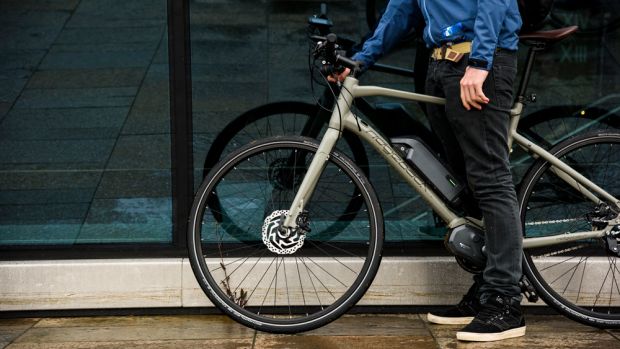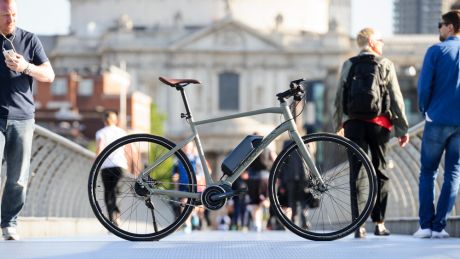You can trust Coach
Electric bikes are an excellent way for city folk to get around. They’re fast, reliable (more reliable than public transport at any rate) and require just the right amount of effort to move – around the same as walking – so you can ride into your place of work without needing a change of clothes.
The flip side to this is that e-bikes are usually heavy, cumbersome beasts that trade style for substance in the shape of a huge battery and motor. This is where the Ridgeback E-Flight Di2 sets itself apart, with a sleek, stylish design that means it doesn’t require a forklift to move. Ridgeback doesn’t give the exact weight of the Di2, but it passed the ultimate test of an e-bike’s weight with flying colours – getting it up the narrow staircase to my flat easily.
Ridgeback has taken the design of its regular Flight bike range and added a battery and motor to create an e-bike that’s made for commuting. The svelte frame means you can comfortably slip through stationary traffic and with the powerful Shimano Steps motor spurring on the lightweight frame, you’ll fly along even with the lowest level of assist.
There are three levels of assistance to choose from – eco, normal and high – but aside from hills I never felt the need to move out of eco mode. Punching it up to high was largely pointless because I’d quickly end up going over 25km/h, which means the motor cuts out (by law) anyway.
When the battery’s fully charged the E-Flight Di2’s expected range is around 90km on eco, 75-80km on normal and 60-65km on high. In practice you’ll probably get a little more than this because the bike is speedy enough to comfortably go over 25km/h regularly and thus save the battery a little.
However, the readout on the screen on the handlebars, which details how far you can go on the current charge, jumped around in confusing fashion as I rode. I found that it would steadily climb as I was cycling and I’d finish the ride with an expected range 10km longer than when I started. When I started the bike up again the range dropped to what I assume is a more accurate estimation.
You also have to be careful not to ask too much of the battery. If you start a ride with under 10km of range left in eco, and then pop it into high for just a few seconds, you’re likely to run out of juice. This happened to me halfway up a hill at the start of my morning commute – but it inadvertently gave the E-Flight Di2 a chance to shine as I was compelled to ride it without any assist, which proved surprisingly comfortable.
Sign up for workout ideas, training advice, reviews of the latest gear and more.
For most e-bikes, running out of charge is a disaster because their weight makes them unpleasant to ride without the boost. The Di2, in contrast, can easily be ridden as a normal bike, which can really extend the range because you can turn off the assist regularly.

The E-Flight Di2 also offers automatic gear changing. I’m not a huge fan of this as it always drops the gears too low at traffic lights, so you end up spinning the pedals wildly as you try to pull away and the bike ramps back up through the gears. Thankfully, you can switch it off, and the good news is that if you start in a higher gear to move away from traffic quickly, the motor kicks in quickly and powers you forward. It’s also easy to change gear with the two buttons on the right side of the handlebars. The assist level is controlled in the same way with buttons on the left side.
Other nice touches include the bright lights, which are powered by the battery, the stylish brown leather handlebars and saddle, and the large screen controlled with one button which gives all the details on your ride and battery life.
Of course, all of this comes at a price. The Ridgeback E-Flight Di2 falls in line with its electric brethren, costing £2,799.99, but regular Ridgeback Flight bikes cost between £699 and £1,099. Also available for slightly less (£2,499.99) is the Ridgeback E-Flight, which has a less impressive gear set but otherwise matches up with the Di2.
RECOMMENDED: Scott E-Sub Tour Electric Bike Review (£1,999)
On the other hand, it makes more sense to compare the cost with public transport than with normal bikes, because it’s commuters who are perhaps more likely to convert to e-bikes than current cyclists. With an annual Transport for London Travelcard costing between £1,300 and £2,500 depending on the zones involved, you can certainly expect an e-bike to save you money over several years of use.
The E-Flight Di2 is pricy even for an e-bike, but what you get for your money is a very well-designed ride that counters the classic problems of e-bikes, namely the weight and clunky looks. The cherry on top is the ability to ride it easily even when the juice runs out, removing a major worry of e-bike use.
£2,799.99, buy on ridgeback.co.uk

Nick Harris-Fry is a journalist who has been covering health and fitness since 2015. Nick is an avid runner, covering 70-110km a week, which gives him ample opportunity to test a wide range of running shoes and running gear. He is also the chief tester for fitness trackers and running watches, treadmills and exercise bikes, and workout headphones.

